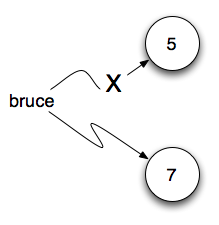2.10. Reassignment¶
As we have mentioned previously, it is legal to make more than one assignment to the same variable. A new assignment makes an existing variable refer to a new value (and stop referring to the old value).
The first time bruce is
printed, its value is 5, and the second time, its value is 7. The assignment statement changes
the value (the object) that bruce refers to.
Here is what reassignment looks like in a reference diagram:

It is important to note that in mathematics, a statement of equality is always true. If a is equal to b
now, then a will always equal to b. In Python, an assignment statement can make
two variables refer to the same object and therefore have the same value. They appear to be equal. However, because of the possibility of reassignment,
they don’t have to stay that way:
Line 4 changes the value of a but does not change the value of
b, so they are no longer equal. We will have much more to say about equality in a later chapter.
Note
In some programming languages, a different
symbol is used for assignment, such as <- or :=. The intent is
that this will help to avoid confusion. Python
chose to use the tokens = for assignment, and == for equality. This is a popular
choice also found in languages like C, C++, Java, and C#.
Check your understanding
- (A) x is 15 and y is 15
- Look at the last assignment statement which gives x a different value.
- (B) x is 22 and y is 22
- No, x and y are two separate variables. Just because x changes in the last assignment statement, it does not change the value that was copied into y in the second statement.
- (C) x is 15 and y is 22
- Look at the last assignment statement, which reassigns x, and not y.
- (D) x is 22 and y is 15
- Yes, x has the value 22 and y the value 15.
data-10-1: After the following statements, what are the values of x and y?
x = 15
y = x
x = 22